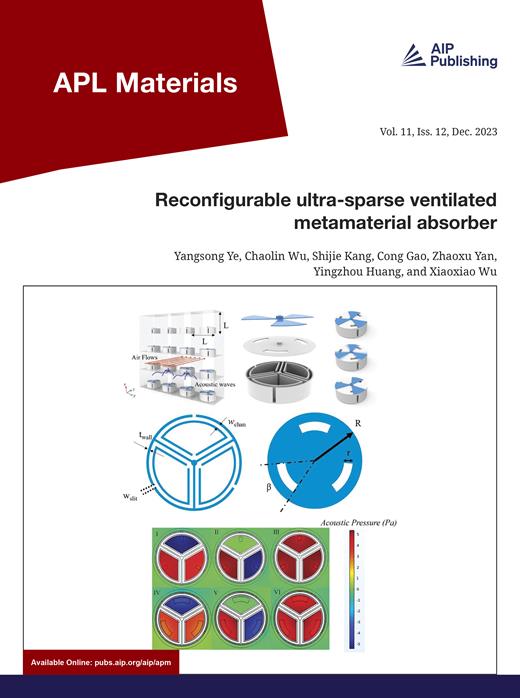Patterning and epitaxy of large-area arrays of nanoscale complex oxide epitaxial heterostructures
IF 5.3
2区 材料科学
Q2 MATERIALS SCIENCE, MULTIDISCIPLINARY
引用次数: 0
Abstract
A combination of block copolymer (BCP) lithography and solid-phase epitaxy can be employed to form large areas, on the order of square centimeters, of a high density of epitaxial crystalline complex oxide nanostructures. We have used BCP lithography with a poly(styrene-block-methyl methacrylate) (PS-b-PMMA) copolymer to template a nanohole array either directly on an (001)-oriented SrTiO3 (STO) single crystal substrate or on a 20 nm-thick Si3N4 layer deposited on the STO substrate. BCPs with the selected compositions assembled in a cylindrical phase with 16 nm diameter PMMA cylinders and a cylinder-to-cylinder spacing of 32 nm. The substrate was modified with an energetically non-preferential polymer layer to allow for the vertical alignment of the cylinders. The PMMA cylinders were removed using a subtractive process, leaving an array of cylindrical holes. For BCPs assembled on Si3N4/STO, the pattern was transferred to the Si3N4 layer using reactive ion etching, exposing the underlying STO substrate in the nanoholes. An amorphous LaAlO3 (LAO) layer was deposited on the patterned Si3N4/STO at room temperature. The amorphous LAO epitaxially crystallized within the nanoscale-patterned holes with fully relaxed lattice parameters through solid phase epitaxy, resulting in the formation of nanoscale LAO/STO epitaxial heterostructures.纳米级复杂氧化物外延异质结构大面积阵列的制图和外延
将嵌段共聚物 (BCP) 光刻技术和固相外延技术相结合,可以形成大面积、约平方厘米的高密度外延结晶复合氧化物纳米结构。我们使用聚(苯乙烯-嵌段-甲基丙烯酸甲酯)(PS-b-PMMA)共聚物进行 BCP 光刻,在取向为 (001) 的 SrTiO3(STO)单晶基底上或沉积在 STO 基底上的 20 纳米厚 Si3N4 层上直接模板化纳米孔阵列。所选成分的 BCP 以直径为 16 nm 的 PMMA 圆柱和 32 nm 的圆柱间距组装成圆柱相。基底被改性为无能量偏好的聚合物层,以实现圆柱的垂直排列。使用减法工艺去除 PMMA 圆柱,留下圆柱孔阵列。对于组装在 Si3N4/STO 上的 BCP,使用反应离子蚀刻将图案转移到 Si3N4 层,从而在纳米孔中暴露出下层的 STO 基底。室温下,在图案化的 Si3N4/STO 上沉积了非晶 LaAlO3(LAO)层。通过固相外延,非晶态 LAO 以完全松弛的晶格参数在纳米级图案孔内外延结晶,从而形成了纳米级 LAO/STO 外延异质结构。
本文章由计算机程序翻译,如有差异,请以英文原文为准。
求助全文
约1分钟内获得全文
求助全文
来源期刊

APL Materials
NANOSCIENCE & NANOTECHNOLOGYMATERIALS SCIE-MATERIALS SCIENCE, MULTIDISCIPLINARY
CiteScore
9.60
自引率
3.30%
发文量
199
审稿时长
2 months
期刊介绍:
APL Materials features original, experimental research on significant topical issues within the field of materials science. In order to highlight research at the forefront of materials science, emphasis is given to the quality and timeliness of the work. The journal considers theory or calculation when the work is particularly timely and relevant to applications.
In addition to regular articles, the journal also publishes Special Topics, which report on cutting-edge areas in materials science, such as Perovskite Solar Cells, 2D Materials, and Beyond Lithium Ion Batteries.
 求助内容:
求助内容: 应助结果提醒方式:
应助结果提醒方式:


